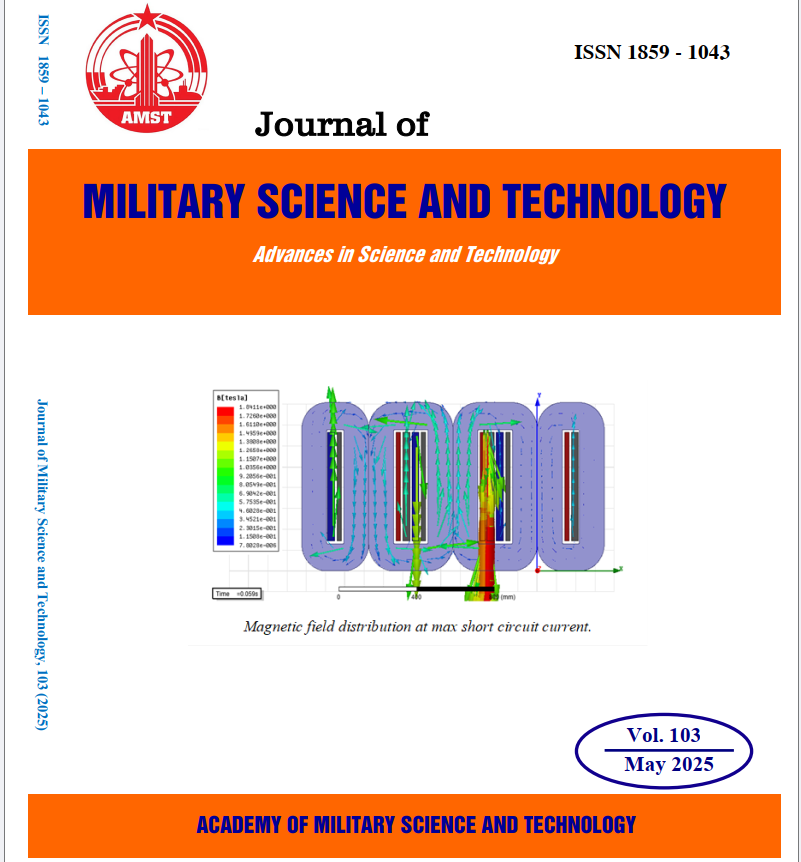The study on the ability to treat picric acid in water using the indirect photoelectrocatalytic oxidation method with a WO3/Cu electrode
285 viewsDOI:
https://doi.org/10.54939/1859-1043.j.mst.103.2025.65-73Keywords:
Tungsten trioxide, Electrochemical, TNPAbstract
The article presents the results of a study on the fabrication and evaluation of certain properties, morphology, crystal structure of the WO₃ coating on a Cu substrate. Simultaneously, the article introduces the preliminary results of evaluating the ability to treat picric acid in water using the indirect electrochemical oxidation method with a WO₃/Cu electrode and HOCl as the oxidizing agent. The research results show that the WO₃ coating on Cu substrate has a hexagonal crystal structure, a density of 6.422 g/cm³, an absorption intensity of 0.8 a.u (λ = 420 nm), and an energy bandgap of approximately 2.8 eV. With an applied potential of +0.8 V (vs. Ag/AgCl) to the WO₃/Cu electrode, the indirect photoelectrochemical oxidation method using the WO₃/Cu electrode and HOCl as the oxidizing agent achieves a 95% treatment efficiency for TNP at a concentration of 80 mg/L after 105 minutes at room temperature.
References
[1]. “Picric-Acid @ pubchem.ncbi.nlm.nih.gov.” 1.[Online]. Available: https://pubchem.ncbi.nlm.nih.gov/compound/Picric-Acid
[2]. J. Gong, Y. Liu, and X. Sun, “O3 and UV/O3 oxidation of organic constituents of biotreated municipal wastewater,” Water Res., vol. 42, no. 4, pp. 1238–1244, (2008), doi: https://doi.org/10.1016/j.watres.2007.09.020. DOI: https://doi.org/10.1016/j.watres.2007.09.020
[3]. E. Brillas, I. Sirés, and M. A. Oturan, “Electro-Fenton process and related electrochemical technologies based on Fenton’s reaction chemistry,” Chem. Rev., vol. 109, no. 12, pp. 6570–6631, (2009), doi: 10.1021/cr900136g. DOI: https://doi.org/10.1021/cr900136g
[4]. D. Tang, Z. Zheng, K. Lin, J. Luan, and J. Zhang, “Adsorption of p-nitrophenol from aqueous solutions onto activated carbon fiber,” J. Hazard. Mater., vol. 143, no. 1, pp. 49–56, (2007), doi: https://doi.org/10.1016/j.jhazmat.2006.08.066. DOI: https://doi.org/10.1016/j.jhazmat.2006.08.066
[5]. R. M. Farsi et al., “Biodegradation of picric acid (2,4,6-trinitrophenol, TNP) by free and immobilized marine Enterococcus thailandicus isolated from the red sea, Saudi Arabia,” Egypt. J. Aquat. Res., vol. 47, no. 3, pp. 307–312, (2021), doi: https://doi.org/10.1016/j.ejar.2021.05.002. DOI: https://doi.org/10.1016/j.ejar.2021.05.002
[6]. C. A. Martínez-Huitle and S. Ferro, “Electrochemical oxidation of organic pollutants for the wastewater treatment: direct and indirect processes.,” Chem. Soc. Rev., vol. 35, no. 12, pp. 1324–1340, (2006), doi: 10.1039/b517632h. DOI: https://doi.org/10.1039/B517632H
[7]. S. Wang, D. Zhong, G. Qu, P. Ning, J. Quan, and X. Chen, “Degradation of phenol in wastewater with ozone produced by self-design ozone generator,” vol. 02002, (2016). DOI: https://doi.org/10.1051/matecconf/20168202002
[8]. W. S. Koe, J. W. Lee, W. C. Chong, Y. L. Pang, and L. C. Sim, “An overview of photocatalytic degradation: photocatalysts, mechanisms, and development of photocatalytic membrane,” Environ. Sci. Pollut. Res., vol. 27, no. 3, pp. 2522–2565, (2020), doi: 10.1007/s11356-019-07193-5. DOI: https://doi.org/10.1007/s11356-019-07193-5
[9]. M. S. Koo, X. Chen, K. Cho, T. An, and W. Choi, “In Situ photoelectrochemical chloride activation using a WO3 electrode for oxidative treatment with simultaneous H2 evolution under visible light,” Environ. Sci. Technol., vol. 53, no. 16, pp. 9926–9936, (2019), doi: 10.1021/acs.est.9b02401. DOI: https://doi.org/10.1021/acs.est.9b02401
[10]. Y. Wang, Y. Xue, and C. Zhang, “Generation and application of reactive chlorine species by electrochemical process combined with UV irradiation: Synergistic mechanism for enhanced degradation performance,” Sci. Total Environ., vol. 712, p. 136501, (2020), doi: https://doi.org/10.1016/j.scitotenv.2020.136501. DOI: https://doi.org/10.1016/j.scitotenv.2020.136501
[11]. F. Zheng et al., “Tertiary structure of cactus-like WO3 spheres self-assembled on Cu foil for supercapacitive electrode materials,” Journal of Alloys and Compounds, vol. 712. pp. 345–354, (2017). doi: 10.1016/j.jallcom.2017.04.094. DOI: https://doi.org/10.1016/j.jallcom.2017.04.094
[12]. L. Knijff, M. Jia, and C. Zhang, “Electric double layer at the metal-oxide/electrolyte interface,” K. Wandelt and G. B. T.-E. of S.-L. I. (First E. Bussetti, Eds., Oxford: Elsevier, pp. 567–575, (2024). doi: https://doi.org/10.1016/B978-0-323-85669-0.00012-X. DOI: https://doi.org/10.1016/B978-0-323-85669-0.00012-X
[13]. P. Makuła, M. Pacia, and W. Macyk, “How to correctly determine the band gap energy of modified semiconductor photocatalysts based on UV–Vis spectra,” J. Phys. Chem. Lett., vol. 9, no. 23, pp. 6814–6817, (2018), doi: 10.1021/acs.jpclett.8b02892. DOI: https://doi.org/10.1021/acs.jpclett.8b02892
[14]. D. Sánchez-Martínez and D. B. Hernandez-Uresti, “Chapter 13 - Nanostructured-based WO3 photocatalysts: Recent development, activity enhancement, perspectives and applications for wastewater treatment,” E. I. García-López and L. B. T.-M. S. in P. Palmisano, Eds., Elsevier, pp. 211–220, (2021). doi: https://doi.org/10.1016/B978-0-12-821859-4.00008-8. DOI: https://doi.org/10.1016/B978-0-12-821859-4.00008-8
[15]. P. Kolhe, P. Shirke, N. Maiti, M. More, and K. Sonawane, “Facile hydrothermal synthesis of WO3 nanoconifer thin film: Multifunctional behavior for gas sensing and field emission applications,” J. Inorg. Organomet. Polym. Mater., vol. 29, (2019), doi: 10.1007/s10904-018-0962-0. DOI: https://doi.org/10.1007/s10904-018-0962-0
[16]. Z. Tasic, V. K. Gupta, and M. M. Antonijevic, “The mechanism and kinetics of degradation of phenolics in wastewaters using electrochemical oxidation,” Int. J. Electrochem. Sci., vol. 9, no. 7, pp. 3473–3490, (2014), doi: 10.1016/s1452-3981(23)08025-2. DOI: https://doi.org/10.1016/S1452-3981(23)08025-2
[17]. H. Liang, “Development of titania nanotube films for degradation of the recalcitrant organic pollutants in water”, (2009).
[18]. N. Bensalah and A. Gadri, “Electrochemical oxidation of 2,4,6-Trinitrophenol on Boron-doped diamond anodes,” J. Electrochem. Soc., vol. 152, pp. D113–D116, (2005), doi: 10.1149/1.1904942. DOI: https://doi.org/10.1149/1.1904942







